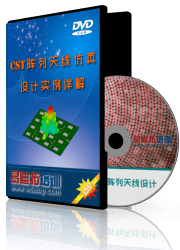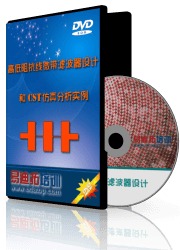- 易迪拓培训,专注于微波、射频、天线设计工程师的培养
CST2013 MWS Examples: Signal Integrity: Simulation of Via Model
Abstract
The miniaturization and the large-scale integration of electronic devices place increasing demand on the multilayer interconnect geometry. The layout of printed circuit boards (PCBs) involves a large number of discontinuities, and their presence causes signal distortion and all the related problems for the mounted digital devices. For this reason an accurate modeling of discontinuities at PCB level is essential for signal integrity (SI) analysis. A methodology is presented in this tutorial for the analysis and the characterization of a simple via hole in multilayer PCB.
Contents
Introduction
Physical Description
In general, signal integrity refers to the quality of an electrical signal or pulse on the interconnect track of a PCB or component. Electronic signals, particularly high speed signals will deteriorate, distort or oscillate if the designer has not made allowances for impedance matching and signal transmission effects. In other words, signal integrity refers to electronic circuit tools and techniques which ensure that electrical signals are of sufficient quality for proper operation. Alternatively, signal integrity tools attempt to identify and remove effects that cause a design to malfunction due to distortion of the signal wave forms. The main cause of signal integrity problems is noise induced by neighboring connections, or cross-talk.
CST MICROWAVE STUDIO Model
Parameter definition and preliminary settings
A single-ended via hole connecting 100mils long microstriplines located on the top and on the bottom of a multilayer PCB is illustrated in Figure 1. The used materials are copper (σ = 5.8e7 S/m) for the metal parts and FR4 isola (εr = 4.19 loss free) for the dielectric. Solder mask substrate on top and bottom is also defined by using loss free dielectric type with εr = 3.6.
Four shorting vias connecting the two power (PWR) planes are also modeled in order to investigate their impact on the return loss.

Figure 1 - CST MICROWAVE STUDIO model of a single-ended via connecting two short microstriplines.
In figure 2, a top view of the structure is illustrated using the typical denomination according to the SI terminology for the different parts of the model.

Figure 2 - Top view of the CST MICROWAVE STUDIO model
The structure is fully parameterized, so that eventual parameter sweep analysis as well as optimization can be easily performed. Table 1 shows the list of the available parameters. However, in this tutorial only the incidence of the antipad radius on the insertion loss as well as on the Time Domain Reflectometry (TDR) wave form will be investigated.

Table 1 - Parameter List
Due to the perfect symmetry of the structure, a symmetry plane can be defined in the Boundary Conditions settings by selecting Simulation: Settings  Boundaries
Boundaries  and this will allow saving 50% of the total cells in the mesh generation.
and this will allow saving 50% of the total cells in the mesh generation.
The simulations are performed using the transient solver of CST MICROWAVE STUDIO which is best suited for SI applications.
|
|
Figure 3 - Boundary condition settings
Simulated 1D and 2D Results
Particular attention has been given to the excitation: the two ”ports” at which the electrical fields and the S-parameters are evaluated are the upper surface of the microstriplines. In order to ensure a TEM structure of the electromagnetic field (essential condition for a meaningful interpretation of the scattering matrix), lumped voltage sources are not suitable because they would excite higher order modes. Because of this, the TEM excitation has been given by considering fictitious wave guide structures (named waveguide port) that cause a TEM or quasi-TEM structure of the field at these planes. Figure 4 depicts the mode pattern, the Beta, the line impedance as well as the wave impedance value.

Figure 4 - Port mode plotting
The S-parameters (in the range 0-50GHz) and the TDR are evaluated, and the wave forms are reported in Figure 5. These informations are of main interest for SI device characterization since they allow the design engineer to have an overview of both time and frequency domain performance.
|
|
Figure 5 - S-parameters and TDR
In addition a time domain monitor can be used to analyze and visualize the transient field distribution in the device as shown in the following picture:

Figure 6 - Z component of the electric field in logarithmic scaling
Parameter Sweep Analysis
At this point, a parameter sweep (see Figure 7) for the via antipad radius is performed in order to study the impact on the general performance of the model. The parameters have been defined so that the shorting vias are automatically adjusted in their position to the new value of the antipad. Insertion loss and TDR are illustrated in Figure 8.

Figure 7 - Parameter sweep dialog and settings
|
|
Figure 8 - Insertion loss and TDR due to the variation of the antipad radius (gviaR)
Important considerations can be addressed:
By increasing the radius of the antipad the insertion loss gets worse.
By increasing the radius of the antipad the TDR impedance presents a larger deviation from the nominal value.
A common assumption in designing vias in PCBs is that by increasing the antipad radius there is an improvement on the insertion loss. The different behavior which is observed in the present example is because of the presence of the shorting vias whose distance from the signal via is automatically increased with the increased value of the antipad radius. Therefore, a different return path to the current is provided.
Conclusion
This simple study shows the importance of the 3D full wave simulation when dealing with PCB discontinuities and high frequencies: even a simple structure (like a single-ended via hole with two short lines) can have unexpected results.
CST微波工作室培训课程套装,专家讲解,视频教学,帮助您快速学习掌握CST设计应用
上一篇:CST2013 MWS Examples: One-way Transmission Device
下一篇:CST2013 MWS Examples: Three Line Taper (Single-Ended)
CST中文视频培训教程 | More...
 最全面、最专业的CST微波工作室视频培训课程,可以帮助您从零开始,全面系统学习CST的设计应用【More..】
最全面、最专业的CST微波工作室视频培训课程,可以帮助您从零开始,全面系统学习CST的设计应用【More..】
频道总排行
- Rectangular Waveguide Tutorial
- FSS: Simulation of Resonator
- CST2013 MWS Examples: Thermal C
- Dipole Antenna Array - CST201
- CST MWS Examples - CST2013 M
- Microstrip Radial Stub - CST2
- Dielectric Resonator Antenna -
- Interdigital Capacitor - CST20
- CST2013 MWS Examples: Biological
- Lossy Loaded Waveguide - CST2










